The web development languages of WordPress are daunting to many of us. And if you’re in digital marketing, with a lot on your plate, learning PHP, JavaScript, HTML, and CSS mightn’t be high on your list. But if your agency sells WordPress websites, and if you’re the link between clients and developers, familiarity with WordPress development languages is a must. This is what we believe at White Label Agency and it’s helped us grow to become the world’s leading supplier of WordPress outsourcing services to digital marketing agencies.
At WLA, our inside sales team speak the development languages of WordPress. We train them in it. They walk our developers through build requirements, then shuttle back and forth between customers and developers during the entire course of development projects. This ensures our customers get what they want. It drives growth for us — as it can for you.
Let’s review the basics of the four main WordPress web development languages: PHP, JavaScript, HTML, and CSS are used in WordPress websites.

The ecosystem of WordPress
A great range of development languages can be used in the WordPress environment. Each contributing new possibilities for the function, look and feel of a website. In addition, WordPress brings to bear other technologies, such as plugins and themes which simplify the developer’s task and contribute further to the platform’s versatility and user-friendliness. This is part of the reason why WordPress is the most popular CMS: options available to developers and designers are vast. Yet, for some, this can be overwhelming, given the breadth of knowledge required to fully harness WordPress.
Four web development languages form the foundation of the WordPress ecosystem and are used in all website builds: PHP, JavaScript, HTML, and CSS. They act in concert to establish the functional infrastructure and aesthetics of WordPress websites.
PHP is a server-side scripting language that is used to process data and generate dynamic content. It is responsible for the backend of the website, such as handling user input, displaying data from a database, and creating custom features. JavaScript is used to add interactivity to a website. It can be used to create animations, slideshows, and other interactive features. HTML tells the browser how to display the content of the website, such as the headings, paragraphs, images, and links. Finally, CSS styles the appearance of a website. It controls the look and feel of the website, such as the font, color, and layout of the text, images, and other elements.
Let’s examine each of these WordPress development languages in more detail.
SERVICES
WordPress development agency
We’re a WordPress development agency that works exclusively for digital agencies. We build custom websites based on your specs.
Driving the back-end with PHP
PHP is a server-side scripting language that is used to process data and generate dynamic content. It is responsible for the backend of the website, such as handling user input, displaying data from a database, and creating custom features. For example, a PHP script could be used to:
- Collect a user’s name and email address, store it in a database, and then display a personalized greeting to the user.
- Create a login system that allows users to log in to their account and access protected content.
- Generate a shopping cart that allows users to add items to their cart and checkout.
- Create a forum where users can post messages and replies.
Add interactivity with JavaScript
JavaScript is a scripting language that is used to add interactivity to a website. It can be used to create animations, slideshows, and other interactive features. For example, a JavaScript script could be used to:
- Make a button on a website change color when it is clicked.
- Make a pop-up window appear when the user hovers over an image.
- Create a game that the user can play.
- Add a search bar to the website.
Structure the website with HTML
HTML is a markup language that is used to define the structure of a website. It tells the browser how to display the content of the website, such as the headings, paragraphs, images, and links. For example, an HTML tag could be used to:
- Create a heading.
- Create a paragraph.
- Insert an image.
- Create a link to another page.
- Create a form for the user to fill out.

Style aesthetics with CSS
CSS is a stylesheet language that is used to style the appearance of a website. It controls the look and feel of the website, such as the font, color, and layout of the text, images, and other elements. For example, a CSS rule could be used to:
- Make all of the headings on a website blue, 20 pixels tall, and bold.
- Set the background color of the website to white and the text color to black.
- Center the text on the page and make the images 50% of the width of the page.
- Create a tabbed navigation menu.
Close the gap between your customers and developers
Don’t let the complexities of web development languages intimidate you and create a chasm between your clients and developers. Instead, close this gap by fostering an interest in PHP, JavaScript, HTML, and CSS. It’s not about becoming a developer, but about ensuring clear communication and successful project outcomes.
At The White Label Agency, we understand the need for effective collaboration between your client contact and developers. By excelling in this, we’ve amassed a portfolio of over 10,000 development projects with over 600 agencies. As well as project development, we offer a wide range of WordPress services, including website maintenance. If you would like to find out how we can help your agency deliver clients the websites they want, don’t hesitate to contact our sales team today.
SERVICES
Hire WordPress developer
Hire a WordPress developer from our 150+ team. Scale and grow your business anytime, without the hassle of recruiting a technical team.



